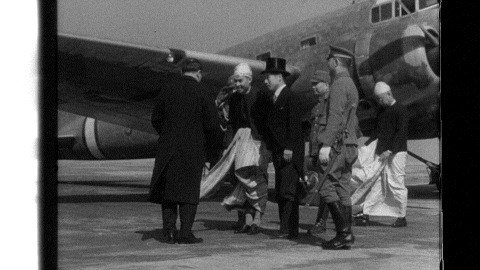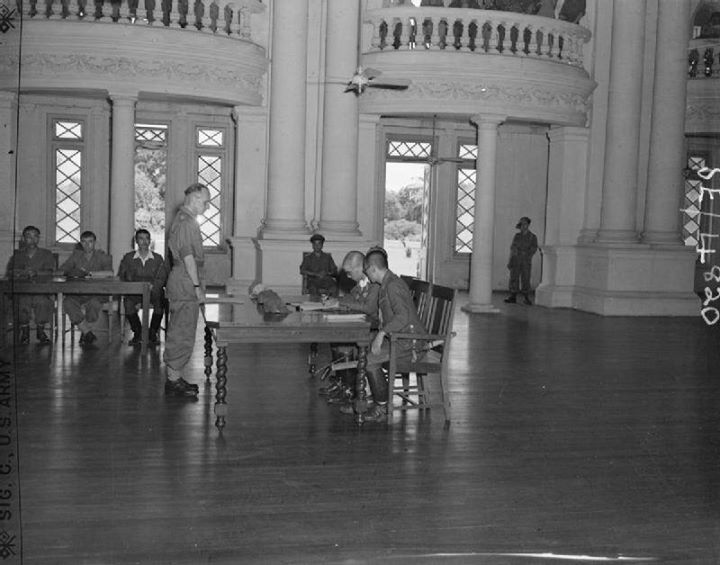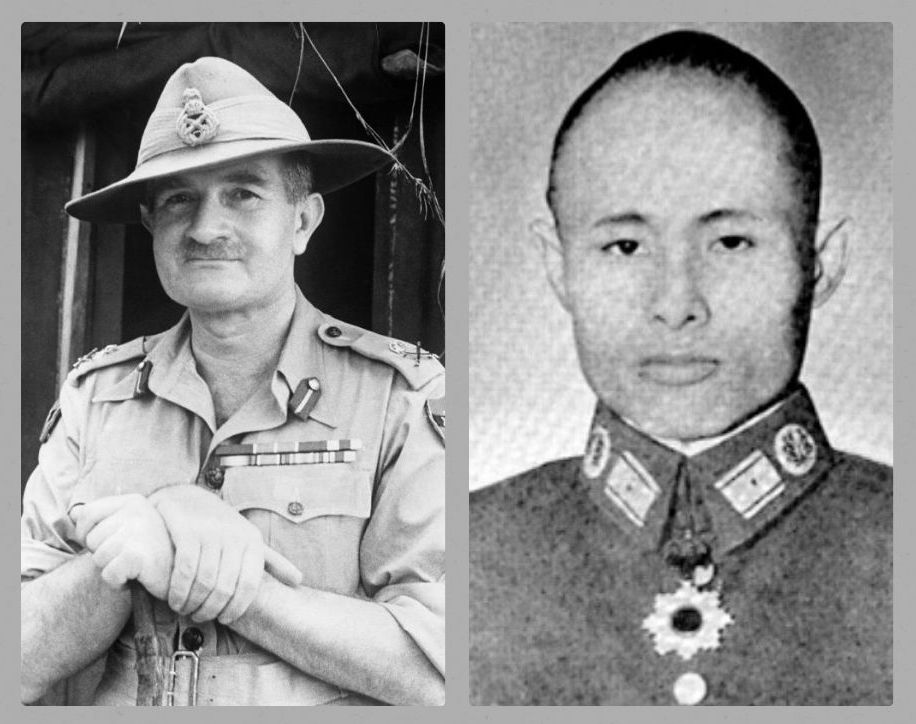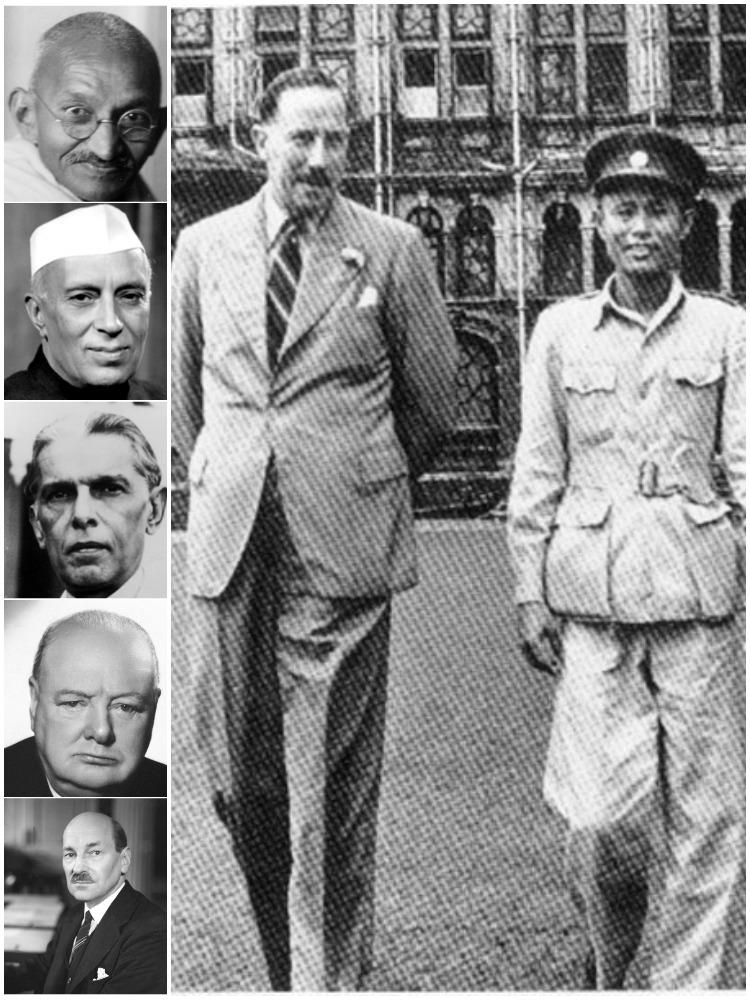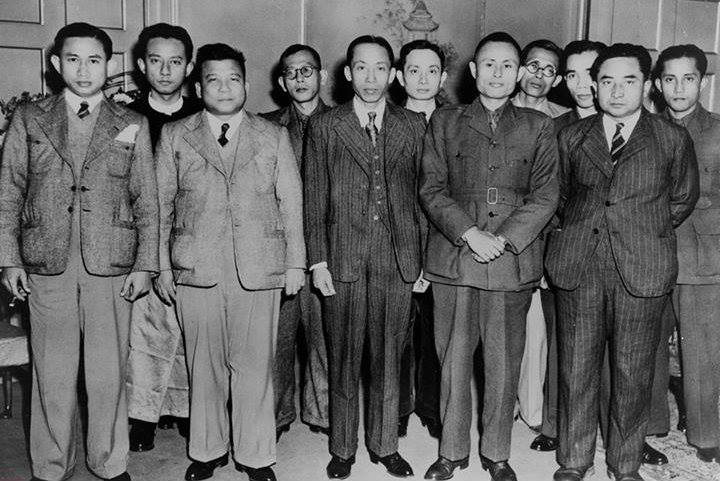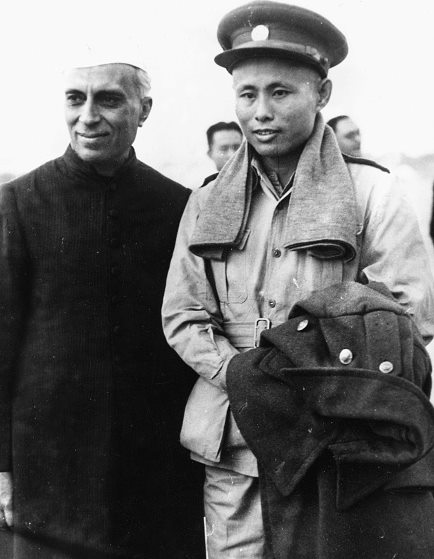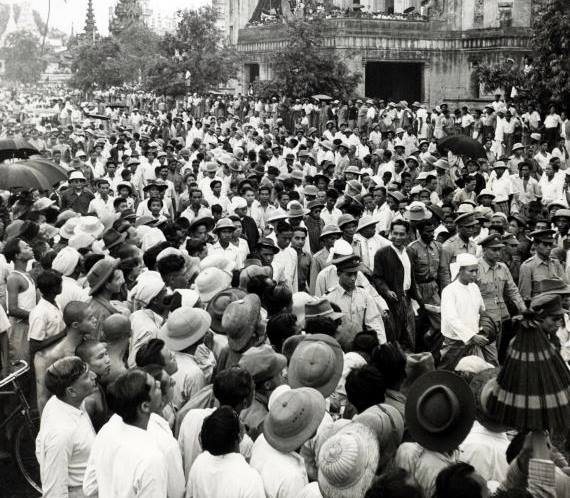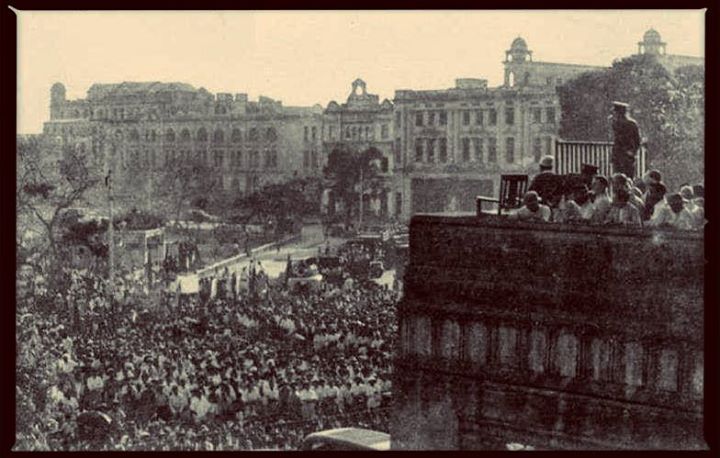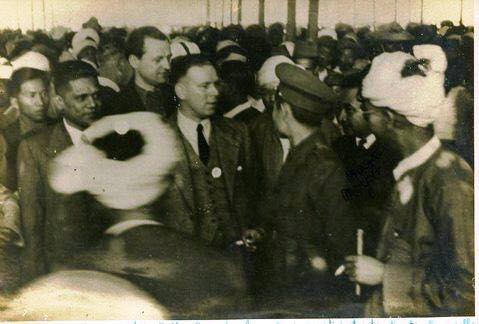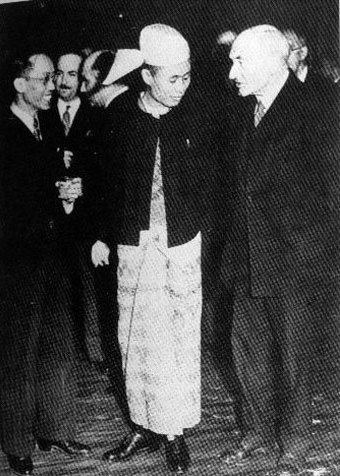General Aung San
Dr. Ba Maw in Tokyo in 1943
In March 1943, Dr Ba Maw travelled to Tokyo (together with Thakin May, U Thein Maung, and General Aung San) for discussions with Japanese Prime Minister Hideki Tojo and others. Five months later, Dr Ba Maw would be proclaimed the adhipati (Leader) of the State of Burma and an ally of the Axis Powers. The Burmese delegation's arrival at Haneda airport in Tokyo was featured on this cover of the Japanese magazine, Shashin Shuho. In the background of both photographs...
Read MoreThe Japanese surrender at Government House, Rangoon
On 12 September 1945, General Ichida Jiro, Acting Chief of Staff of Japan's Burma Area Army, formally surrendered to Brigadier E.F.E. Armstrong (Chief of Staff to Lieutenant-General Sir Montague Stopford, General Officer Commanding of the British Twelfth Army) at Government House, Rangoon. On the same day, Lord Louis Mountbatten, Supreme Allied Commander South East Asia received the Japanese surrender in Singapore. Five days earlier on 7 September, Lord Mountbatten and General Aung San had signed an agreement at Kandy in...
Read MoreRelationship Between Lt. General Slim and General Aung San
General Aung San crossed the Irrawaddy at Allanmyo on 15 May 1945 and then flew to Meiktila on 16 May to meet for the first time with Lt. General William Slim, commander of the British Fourteenth Army. With nearly one million men, the Fourteenth Army was the largest Commonwealth army anywhere during World War Two - a giant force of Indians, Africans, British, Gurkhas, Burmese, Canadians, Australians and others. By 16 May, the Fourteenth Army had already retaken Rangoon and...
Read MoreAllied Forces Holding a Victory Parade Along Shwedagon Pagoda Road
On 15 June 1945, Allied forces under Supreme Allied Commander South East Asia Admiral Lord Louis Mountbatten held a victory parade over the Japanese Empire. Lord Louis Mountbatten took the salute together with other Allied commanders including General Aung San, who had just been given the rank of "Deputy Inspector General". The march past included units of the Indian Army, the Royal Navy, the Royal Marines, the US Army, the Chinese Army, and the "Patriotic Burma Forces" under General Aung...
Read MoreUK's decision to quit Burma
On 20 December 1946, UK Prime Minister Clement Attlee informed the House of Commons of his government's intention "to hasten forward the time when Burma shall realize her independence, either within or without the Commonwealth". In other words, the UK had decided to quit Burma. Clement Attlee's Labour government were coping with severe and mounting economic challenges at home, and facing dire emergencies in India, Palestine, and Greece. Communal violence in India would soon claim the lives of millions. Palestine...
Read MoreGeneral Aung San in London
This photograph shows General Aung San at the Dorchester Hotel in London during negotiations with the UK government in January 1947. He is flanked by Thakin Mya and U Tin Tut (the delegation's principal negotiator). The meetings resulted in the signing of the Aung San-Attlee Agreement, which outlined the conditions for Burma's independence from Britain and was the moment of General Aung San's greatest triumph. Just six months later, Thakin Mya would be killed together with General Aung San, and...
Read MorePhotograph of 31-Year-Old General Aung San
A photograph of General Aung San at his moment of triumph: At 10 Downing Street on 27 January 1947 to negotiate the independence of Burma from the British Empire. To his left is his closest colleague in the talks, ICS U Tin Tut. He was then 31 years old.
Read MoreU Aung San's historic meeting with Pandit Nehru
General Aung San met with Pandit Nehru in Delhi, where he stopped on his way to London to discuss Burmese independence with Prime Minister Clement Attlee. Pandit Nehru realized General Aung San's tropical outfit would not be suitable for London, which was then experiencing one of its coldest winters in history. He gave General Aung San a greatcoat and had two new bespoke uniforms of warmer material made for him. The winter of 1946-47 was to be the UK's coldest...
Read MoreU Aung San leading a demonstration in 1947
In June 1947: U Aung San leads a demonstration down Dalhousie Street to the Secretariat before attending a meeting of the Constituent Assembly.
Read MoreGeneral Aung San's Last Speech
On 13 July 1947, U Aung San gave his last speech from the balcony of City Hall to supporters in Fytche Square (now Maha Bandula Park). He was then the de facto head of an Interim government (formally the Counsellor for Defense and External Affairs and deputy chairman of the Executive Council) under the Governor Sir Hubert Rance. This would be his last speech: U Aung San and nearly his entire Executive Council would be killed less than a week...
Read MoreUnion Day: Anniversary of the 1947 Panglong Agreement
Myanmar's Union Day, which falls on 12 February, marks the anniversary of the Panglong Agreement of 1947. There is considerable mythology surrounding the Panglong Agreement and it is helpful to remember what it was and what it was not. The Panglong Agreement was primarily an agreement on transitional arrangements in the lead up to Burmese independence after World War Two. Of its nine paragraphs, four deal exclusively with the new position of "Counsellor to the Governor to deal with Frontier...
Read MoreAung San-Attlee Agreement
Between 13 and 27 January 1947 discussions took place in London between the British government of Prime Minister Clement Attlee and the visiting Burmese delegation led by General Aung San. These discussions led to the Aung San - Attlee Agreement. The Agreement stated as the "common objective" of its signatories "a free and independent Burma whether within or without the British Commonwealth Nations”. It called for elections to a Constituent Assembly "as soon as possible", and laid out many and...
Read More